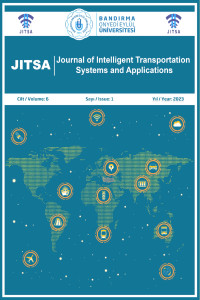Abstract
Sütunlar araçlara gövde sağlamlığı sağladıkları için önemli parçalardandır. Fakat bu sütunlar ayrıca ön cam, yan ve arka camlar arasındaki sağlam ve opak parçalardır. Özellikle A-sütunu olarakta adlandırılan ilk sütun ve son sütun, taşıtların şase gücünü artırmak için mümkün olduğunca kalın tasarlanmıştır. Bu çalışma, aracın A-sütununun neden olduğu kör noktaya odaklanmaktadır. Biri diğerinin kör noktasında kalan iki araç arasındaki hız ilişkilerini belirlemek için sayısal bir analiz yapılmıştır. 9 farklı sürücü senaryosu verilmiştir. Bu senaryolar, sürücünün konumuna ve A-sütununun kesit uzunluğuna bağlıdır. Senaryoların sayısal analizine göre yol vermesi gereken araçlar, düşük hızlarda kavşağa gelmeden 1,62 saniye önce yol vermek zorunda olan aracın geçişini fark eder. Hızın artmasıyla kavşağa ulaşmak için gereken süre önemli ölçüde azalır. Sonuç olarak, kavşaktaki bir kazayı analiz ederken A-sütununun tasarım değerleri de dikkate alınmalıdır.
Keywords
References
- AlMamlook, R. E., Kwayu, K. M., Alkasisbeh, M. R., and Frefer, A. A. (2019). Comparison of machine learning algorithms for predicting traffic accident severity. In 2019 IEEE Jordan International Joint Conference on Electrical Engineering and Information Technology (JEEIT), 272-276.
- Colling, D. A. (1990). Industrial safety: management and technology. Prentice Hall. Hakkert, S. and Mahalel, D. (1978). Estimating the number of accidents at intersections from a knowledge of the traffic flows on the approaches. Accident Analysis & Prevention, 10, 1, 69-79.
- International Traffic Safety Data and Analysis Group (Irtad), (2020). Road Safety Annual Report 2020. International Transport Forum.
- Karayolları Genel Müdürlüğü, (2020). Trafik kazaları özeti. kgm.gov.tr, https://www.kgm.gov.tr/SiteCollectionDocuments/KGMdocuments/Trafik/TrafikKazalariOzeti2017.pdf (Erişim tarihi: 3 Kasım 2020)
- Kashani, A.T. and Mohaymany, A.S. (2011) Analysis of the traffic injury severity on two-lane, two-way rural roads based on classification tree models, Safety Science, 49(10), 1314–1320.
- National Highway Traffic Safety Administration, (2020). Fatality and Injury Reporting System Tool (FIRST), United States Department of Transportation. https://cdan.dot.gov/query
- Özinal, Y. and Uz, V. E. (2021). Dönel Kavşak Geometrik Elemanlarının Kavşak Güvenliği Üzerine Etkisinin Literatür Işığında Değerlendirilmesi. Politeknik Dergisi. 24, 1, 283-297.
- World Health Organization, (2018). Global status report on road safety 2018: Summary (No. WHO/NMH/NVI/18.20). World Health Organization.
Abstract
Pillars are essential since they ensure body strength for vehicles. However, they are solid and opaque parts between the windshield, side and rear windows. Especially the first, A-pillar, and last ones are designed as thick as possible to improve the body strength. This study focuses on the blind spot caused by the A-pillar of the vehicle. A numerical analysis has been performed to determine the velocity relations between the two vehicles. One stays in the blind place of the other one. 9 different driver scenarios have been given. These scenarios depend on the position of the driver and the A-pillar section length. Based on the numerical analysis of the scenarios, vehicles that must give way notice the vehicle passing right 1.62 seconds before they both arrive at the intersection for low speeds. With the increase in speed, the time needed to arrive at the intersection decreases significantly. As a result, the A-pillar design parameters should also be considered when analysing an accident at the intersection.
Keywords
References
- AlMamlook, R. E., Kwayu, K. M., Alkasisbeh, M. R., and Frefer, A. A. (2019). Comparison of machine learning algorithms for predicting traffic accident severity. In 2019 IEEE Jordan International Joint Conference on Electrical Engineering and Information Technology (JEEIT), 272-276.
- Colling, D. A. (1990). Industrial safety: management and technology. Prentice Hall. Hakkert, S. and Mahalel, D. (1978). Estimating the number of accidents at intersections from a knowledge of the traffic flows on the approaches. Accident Analysis & Prevention, 10, 1, 69-79.
- International Traffic Safety Data and Analysis Group (Irtad), (2020). Road Safety Annual Report 2020. International Transport Forum.
- Karayolları Genel Müdürlüğü, (2020). Trafik kazaları özeti. kgm.gov.tr, https://www.kgm.gov.tr/SiteCollectionDocuments/KGMdocuments/Trafik/TrafikKazalariOzeti2017.pdf (Erişim tarihi: 3 Kasım 2020)
- Kashani, A.T. and Mohaymany, A.S. (2011) Analysis of the traffic injury severity on two-lane, two-way rural roads based on classification tree models, Safety Science, 49(10), 1314–1320.
- National Highway Traffic Safety Administration, (2020). Fatality and Injury Reporting System Tool (FIRST), United States Department of Transportation. https://cdan.dot.gov/query
- Özinal, Y. and Uz, V. E. (2021). Dönel Kavşak Geometrik Elemanlarının Kavşak Güvenliği Üzerine Etkisinin Literatür Işığında Değerlendirilmesi. Politeknik Dergisi. 24, 1, 283-297.
- World Health Organization, (2018). Global status report on road safety 2018: Summary (No. WHO/NMH/NVI/18.20). World Health Organization.
Details
| Primary Language | English |
|---|---|
| Subjects | Engineering |
| Journal Section | Articles |
| Authors | |
| Publication Date | March 27, 2023 |
| Submission Date | April 15, 2022 |
| Acceptance Date | November 21, 2022 |
| Published in Issue | Year 2023 Volume: 6 Issue: 1 |

